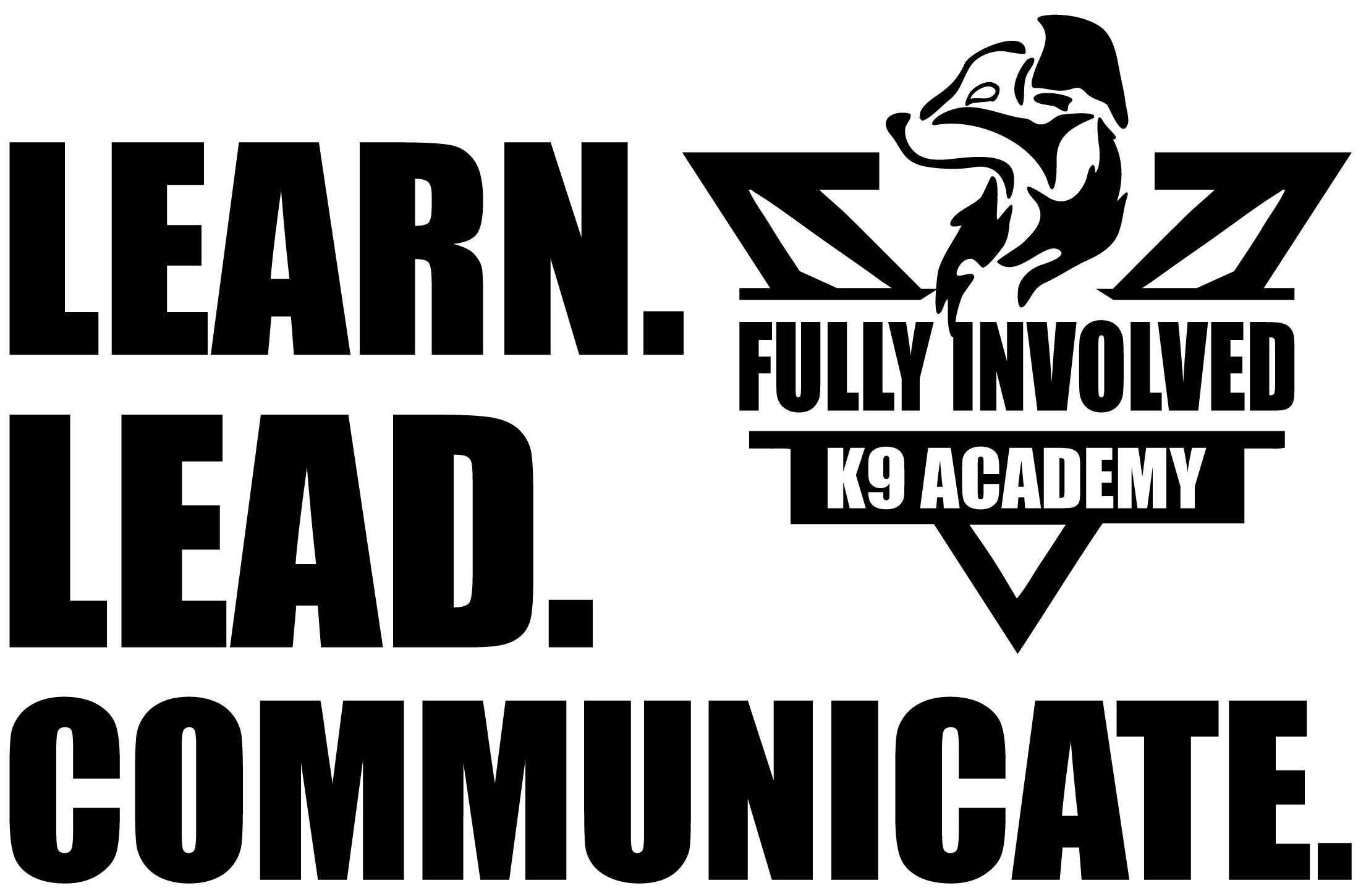It’s winter time, it’s cold and nasty and wet and muddy, who wants to go outside and get a bunch of gear out to do fitness training with their dog? Those of us that live in areas with inclement weather for 6 months out of the year know the deal. Come spring time we will be out training hard to compensate for the deconditioning that has occurred over winter. I suspect the super warm areas of the country may experience this in reverse, when it is 110 F and no one wants to go outside! But missions happen year-round, and I doubt any of us are willing to pass up a mission based on the fact we have not really done anything with the dog for the last couple of months.
In a perfect world we would all have access to an indoor training facility to accommodate us in periods of less than desirable weather. I can close my eyes and see the equipment, all the space I need, strength training equipment, treadmills and swimming pools, odor detection training walls, the list is endless. Then I open my eyes and here I am back in muddy cold northern Virginia with 5 dogs and a single-family home with a yard. So, while we wrestle with ideas of our own personal health and fitness for the new year, I would like to take a few minutes to demonstrate how easily we can incorporate our canine partners into our resolutions, better yet, form new habits and continue to maintain peak physical conditioning year-round.
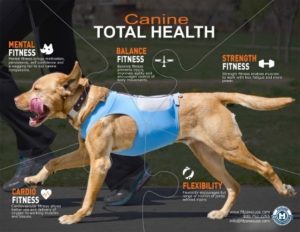 FITPAWs developed the “Total Canine Health” concept, making it clear and simple to develop a fitness program that incorporates all five aspects of canine health and the graphic is gentle reminder that we need to train them in equal parts to develop and maintain a happy, healthy canine partner.
FITPAWs developed the “Total Canine Health” concept, making it clear and simple to develop a fitness program that incorporates all five aspects of canine health and the graphic is gentle reminder that we need to train them in equal parts to develop and maintain a happy, healthy canine partner.
My number one exercise for year-round fitness and conditioning is cavalettis. Cavalettis come from the equine world where they were used to perfect gaits and exercise horses. Think football players high stepping through tires – coach will tell you its about speed and power, flexibility and range and motion and of course cardiovascular conditioning. Cavalettis are commercially available or easily made at home with cones and pipe or garden canes. The cone spacing, and the bar height are all variable depending upon the goal of the session. A simple straight ladder can also be used in leu of the cones; however, it is not as adjustable and versatile. The set up pictured right cost approximately $50, took an hour to construct and is easily set up in a basement or garage space. For more information on cavaletti set up go to https://fullyinvolvedk9.com/cavalettis-set-up. 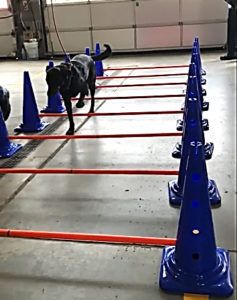
To add a strength training to your canine’s routine there are some simple but important rules that must be followed to ensure the safety and effectiveness of the exercise.
- Balance all exercise – front to back, side to side. Meaning if an exercise works out the front legs and shoulders, find another exercise to work out the rear legs and hips.
- Follow natural range of motions – anticipate where the end points to the range of motion are and take care not to over-extend past those points.
- Slowly increase the intensity and degree of difficulty. Dogs being lured through an exercise will continue past where they should have stopped to get the treat.
Good form is everything. Less intense exercise that are completed with good form are far more beneficial than high rep / high weight exercise with poor form. Good form concepts include keeping joints in natural alignment (knees in line with feet, pointing forward etc).
Begin with perfecting the transitions between sit to stand and down to stand. The goal here is to have the canine fold and unfold, maintaining feet position. Once the canine can move between a square down (shoulders and hips level and legs pointing forward, not off to one side) to a stand and back to a down again without moving their feet, they are ready to move on and increase the difficulty of the exercise
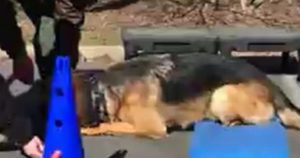
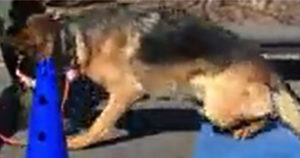
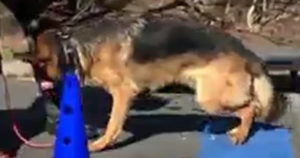
Transition from down to stand with rear legs elevated.
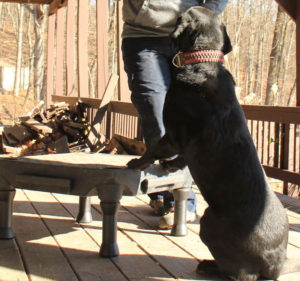
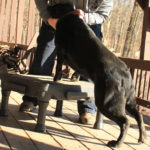 Transition from sit to stand with front legs elevated. Finally, mental health is an often-overlooked component of the total fitness of the canine. Most of our partners get a good brain work out when they complete odor detection training, run though obedience drills and now as they learn now positions and cues for fitness work. A lot of research has been completed on captive animals in zoos and how their mental health can be improved by allowing them to hunt more naturally for their food in their enclosures and interact in a species-specific way with the surroundings. Find you canine a hobby, something away from work that is fun and strengthens the canine human bonds, examples may include dock diving, field trial work or dog tricks. Learning the new cues and interacting with their human in non-stressful way will enhance your understanding of the canine’s personality. Develop behaviors to have duration and work on impulse control cues to really give the brain a work out. Duration behaviors might include the long down or holding a stretch position for 30 seconds. Add a desirable object such as food or a toy and ask for focus and duration before releasing the canine to access the object. Feed meals from puzzle toys to allow the canine to use his brain to forage for his food.By elevating the rear end of the canine, you are placing more weight on the front end – thus working out the shoulders and forelimbs. Conversely by elevating the front end of the canine the weight is distributed to the rear end – thus working out the rear limbs and hips. By adding any component that wobbles – a wobble board, exercise disc, couch cushion the canine is forced to engage more if its abdominal muscles to maintain the position. At home solutions might include feet up on a couch cushion, the bottom tread of the stairs, a box. A wobble board can easily be constructed from a piece of plywood and small block of wood in the center.
Transition from sit to stand with front legs elevated. Finally, mental health is an often-overlooked component of the total fitness of the canine. Most of our partners get a good brain work out when they complete odor detection training, run though obedience drills and now as they learn now positions and cues for fitness work. A lot of research has been completed on captive animals in zoos and how their mental health can be improved by allowing them to hunt more naturally for their food in their enclosures and interact in a species-specific way with the surroundings. Find you canine a hobby, something away from work that is fun and strengthens the canine human bonds, examples may include dock diving, field trial work or dog tricks. Learning the new cues and interacting with their human in non-stressful way will enhance your understanding of the canine’s personality. Develop behaviors to have duration and work on impulse control cues to really give the brain a work out. Duration behaviors might include the long down or holding a stretch position for 30 seconds. Add a desirable object such as food or a toy and ask for focus and duration before releasing the canine to access the object. Feed meals from puzzle toys to allow the canine to use his brain to forage for his food.By elevating the rear end of the canine, you are placing more weight on the front end – thus working out the shoulders and forelimbs. Conversely by elevating the front end of the canine the weight is distributed to the rear end – thus working out the rear limbs and hips. By adding any component that wobbles – a wobble board, exercise disc, couch cushion the canine is forced to engage more if its abdominal muscles to maintain the position. At home solutions might include feet up on a couch cushion, the bottom tread of the stairs, a box. A wobble board can easily be constructed from a piece of plywood and small block of wood in the center.
The reasons for maintaining and training physical and mental fitness in our working partners is documented time and time again, from injury prevention, quicker climate acclimation, quicker recovery times after work, longer working times and overall strength in mind and body to push through when the going gets tough. Afterall the last thing any of us ever want to do is to drive away from a mission with questions of ‘could I have done more’, ‘could we have made the find sooner if I had just got some training in these last few months’. There are many resources available online and at local dog clubs / training centers and of course a veterinarian exam is recommended prior to beginning any workout program.
